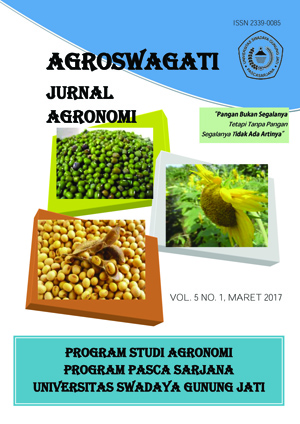RESPON PERTUMBUHAN DAN HASIL TIGA VARIETAS KACANG TANAH (Arachis hypogaea L.) AKIBAT PERLAKUAN JARAK TANAM
DOI:
https://doi.org/10.33603/agroswagati.v5i1.1888Kata Kunci:
Peanuts, Plant Spacing, VarietesAbstrak
This study aims to: (1) the effect of the combination of plant spacing and varieties on the growth and result of peanuts, (2) determine the varieties and spacing gives the best effect among the three varieties on growth and peanut result, (3) determine how the correlation among the components of growth and result of peanuts. The experiment was conducted in UPTD Seed Crops Development Center (BPBD) in Plumbon Cirebon regency, West Java province, from March to June 2016.
The studies conducted by using a randomized block design (RAK) combination model. The treatment consists of two factors, namely peanut varieties and spacing repeated 3 times. Then treatment combination model as follows: A (varieties jerapah and a spacing of 40 cm x 20 cm), B (varieties jerapah and a spacing of 40 cm x 25 cm), C (varieties jerapah and a spacing of 40 cm x 30 cm), D (varieties maja 1 and a spacing of 40 cm x 20 cm), E (varieties maja 1 and a spacing of 40 cm x 25 cm), F (varieties maja 1 and a spacing of 40 cm x 30 cm), G (varieties maja 2 and spacing of 40 cm x 20 cm), H (varieties maja 2 and a spacing of 40 cm x 25 cm) and I (varieties maja 2 and a spacing of 40 cm x 30 cm).
The results showed that: (1) there is a combined effect of plant spacing and varieties of the plant height ages of 21 and 35 days after planting, leaf number aged 21 and 35 days after planting, leaf area index age of 35 HST, root volume age 35 HST, dry biomass of plants per clumps age 35 HST, pod fresh weight per hill and per plot, weight of dry pods per hill and per plot. While the number of pods per hill and a weight of 100 dry seeds no real effect, (2) treatment D (varieties maja 1 and a spacing of 40 x 20 cm) with the result 1,1 ton/ha, E (varieties maja 1 and a spacing of 40 x 25 cm) with the result 1,2 ton/ha, F (varieties maja 1 and a spacing of 40 x 30 cm) with the result 1,1 ton/ha and G (varieties maja 2 and a spacing of 40 x 20 cm) with the result 1,0 ton/ha showed the best effect on weight of dry pods per plot, (3) there was no correlation between plant height ages of 21 and 35 HST , number of leaves ages of 21 and 35 days after planting, leaf area index age of 35 HST, HST 35 root volume, dry biomass of plants per clump age 35 HST by weight of dry pods per plot.Referensi
Adisarwanto, T dan R. Wudianto, 1998.Meningkatkan hasil panen kacang tanah di lahan sawah, kering, pasang surut.Penebar swadaya. Jakarta.
Badan Pusat Statistik. 2014. Produksi Tanaman Pangan 2014. http:// www.bps.go.id/ (20/01/2016).
Brown, R.H. 1984. Growth of The Green Plant. In Tesar, M.B (Ed.).Physiological Basic of Crop Growth and Development.American Society of Agronomy Inc. and Crop Science Society of America Inc. USA. 341p.
Gardner, F. P. ; R. B. Pearce dan R. L. Mitchell. 1991. Fisiologi Tanaman Budidaya. Terjemahan: Herawati Susilo. UI Press, Jakarta.
Indrasti NS. 2003. Pedoman Pengolahan Kacang Tanah. Dirjen Bina Pengolahan dan Pemasaran Hasil Pertanian. Jakarta.
Kemas Ali Hanafiah. 2001. RancanganTeoridanAplikasi.PT. Raja GrafindoPersada. Jakarta.
Kvien C. 1995. Physiological an environmental disorder of peanut.Melouk HA, Shokes FM, editor.Peanut Health Management. Minnesota (US): APS Pr.
Lakitan B. 2008. Dasar-Dasar Fisiologi Tumbuhan. Jakarta (ID): PT. Raja Grafindo Persada
Lukitas, W. 2006. Uji Daya Hasil Beberapa Kultivar Kacang Tanah (ArachishypogaeaL.).Skripsi. Program Studi Agronomi. Fakultas Pertanian. Institut Pertanian Bogor. Bogor
Maesen van den Sar, L. J. G. dan S. Somaatmadja. 1992. Plant Resources of South East Asia No. 1 : Pulses. Prosea.Bogor Indonesia.105 p.
McPhaden, MJ. 2002. El Niño and La Niña: Causes and global consequences. TheEarth system: physical and chemical dimensions of global environmentalchange. Encyclopedia of Global Environmental Change.1:353-370.ISBN 0-471-97796-9.
Moenandir, J. 1988. Persaingan Tanaman Budidaya dengan Gulma. CV. Rajawali. Jakarta. 101 hal.
Muhammad H, Januwati M, Iskandar M. 1993. Pengaruh jarak tanam terhadap produksi daun tempuyung (Sonchus arvensis L.).Warta Tumbuhan Obat Indonesia. Vol. 2 (3) : 13-14.
Nicholls N. 1984. The Southern Oscillation and Indonesian Sea Surface Temperature. Mon.Wea. Rev. 112:424 432. Doi : 10.117/2010JAS3348.1
Purnamawati H, Poerwanto R, Lubis I, Yudiwanti, Rais SA, Manshuri AG. 2010. Akumulasi dan distribusi bahan kering pada beberapa varietas kacang tanah. J Agron Indonesia.38(2):100-106.
Soepardi, G. 1992. Dasar-dasar Ilmu Tanah.IPB Press. Bogor.
Subiharta, B. Hartoyo, dan H. Anwar. 2008. Teknologi sistem usahatani dan ternak berbasis tanaman pangan di lahan kering. Laporan Tahunan Balai Pengkajian Teknologi Pertanian Jawa Tengah.
Suminarti NE. 2000. Pengaruh jarak tanam dan defoliasi daun terhadap hasil tanaman
Trenberth KE. 1997. The Definition of El Niño. Bull Amer Meteor. Soc. 78:2771–2777.doi:10.1175
Vincent Gaspersz. 1995. Metode Perancangan Percobaan. CV. Armico. Bandung.
Webster, P.J., A.M. Moore, J.P. Loschnigg, and R.R. L, 1999: Coupled oceanatmosphere dynamics in the Indian Ocean during 1997-98. Nature, 401,356-360.
Yaqin, N. 1997.Produktivitas Lima Genotipe Kacang Tanah (Arachis hypogeae L.) pada Beberapa Jarak Tanam.Skripsi. Jurusan Budidaya Pertanian. Fakultas Pertanian-IPB.
Unduhan
Diterbitkan
Terbitan
Bagian
Lisensi
The Authors submitting a manuscript do so on the understanding that if accepted for publication, copyright of the article shall be assigned to Jurnal AGROSWAGATI, Sekolah Pascasarjana Ilmu Pertanian. Universitas Swadaya Gunung Jati as publisher of the journal. Copyright encompasses rights to reproduce and deliver the article in all form and media, including reprints, photographs, microfilms, and any other similar reproductions, as well as translations.
Jurnal AGROSWAGATI, Universitas Swadaya Gunung Jati and the Editors make every effort to ensure that no wrong or misleading data, opinions or statements be published in the journal. In any way, the contents of the articles and advertisements published in Jurnal AGROSWAGATIare the sole responsibility of their respective authors and advertisers.











